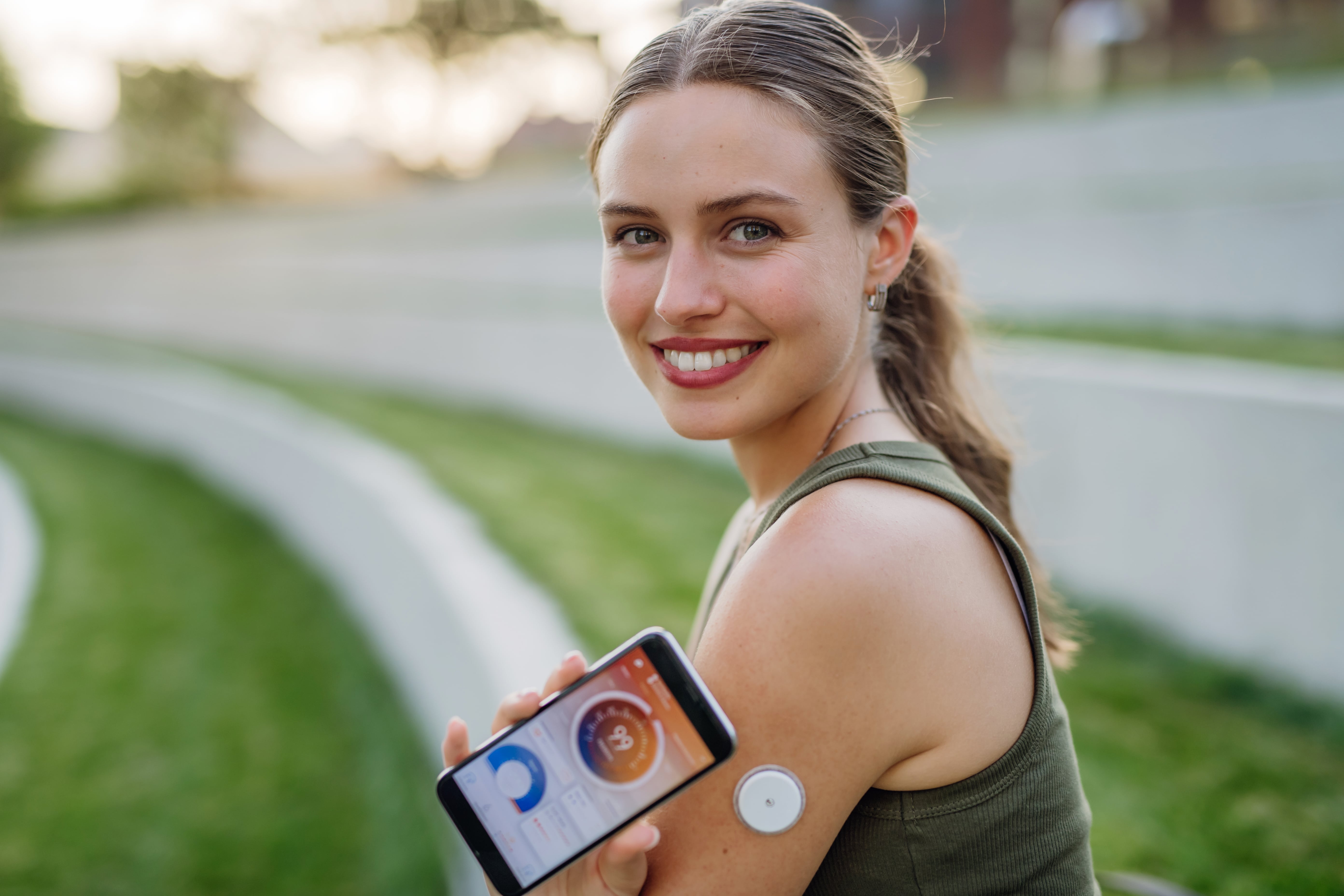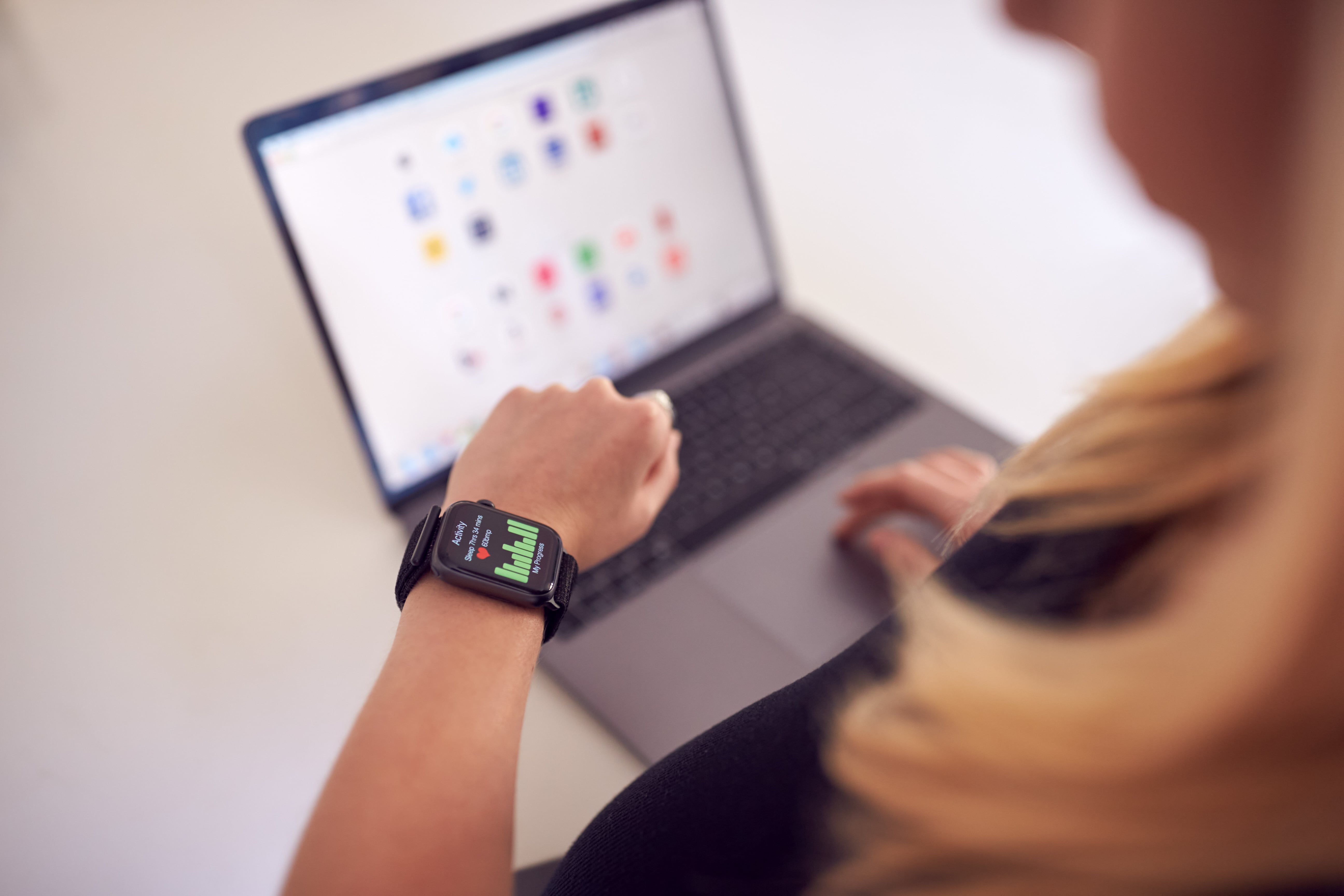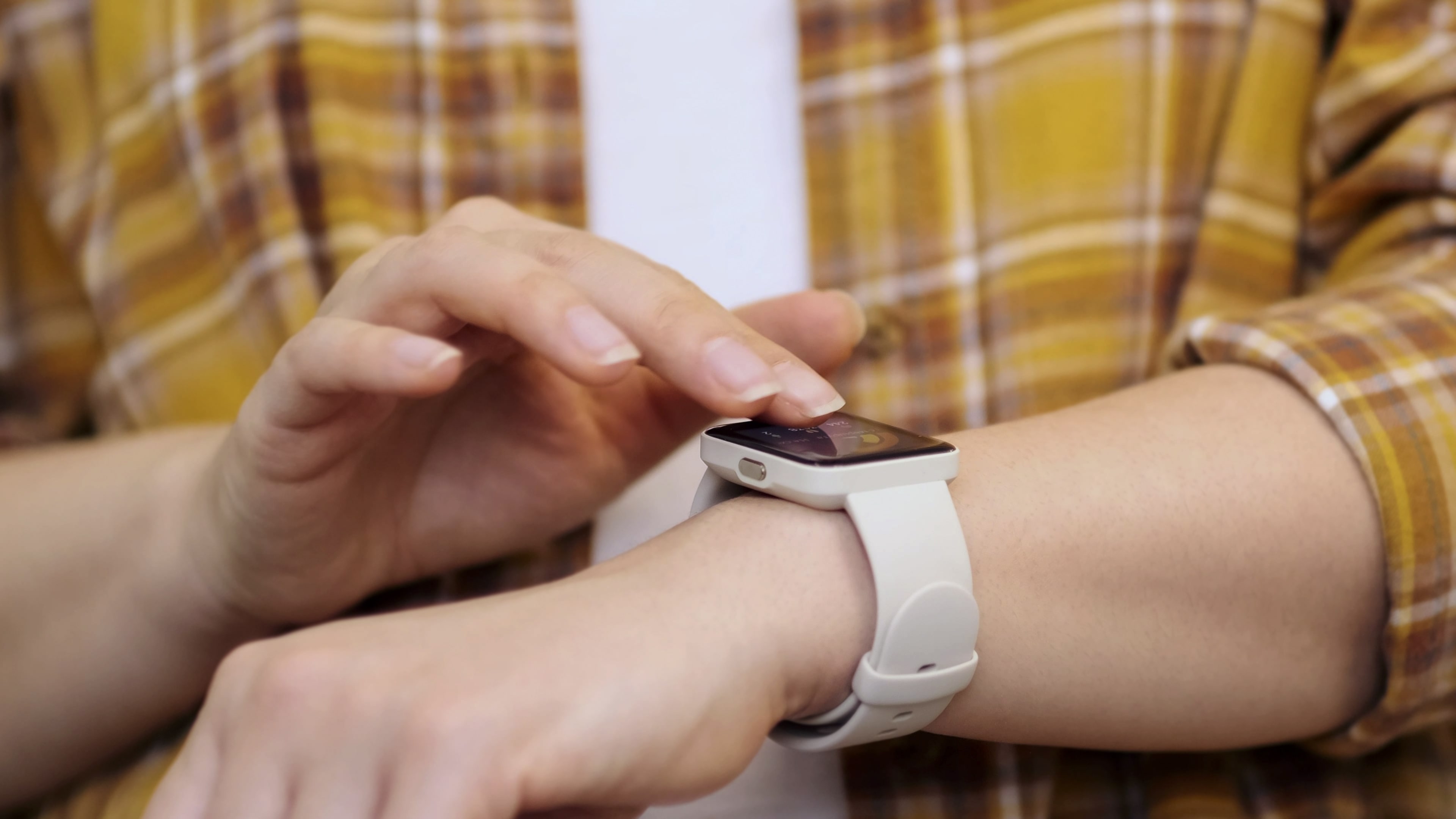Metabolic tech is exploding. Everywhere you look, there’s a new wearable, app, or sensor promising to unlock your body’s secrets: continuous glucose monitors (CGMs), breath analyzers, smart clothing, AI nutrition tools, fitness trackers, and more.
The pitch is shiny: real-time insights at your fingertips. But here’s the truth: some of these tools deliver, and others are just expensive gadgets gathering dust in your drawer.
So how do you know what’s hype and what’s actually helpful? Consider four key factors: safety, real-world performance, usability, and cost. Nail those, and you won’t waste time (or hundreds of dollars) chasing flashy tech that doesn’t move the needle.
The Metabolic Tech on the Rise

Continuous Glucose Monitors (CGMs)
Think of CGMs as the OG metabolic tech. A small sensor sits on your arm, quietly measuring glucose in real time. You see exactly how food, workouts, sleep, and stress play out in your body: spike by spike, dip by dip.
Not all CGMs are built the same, though.
FDA-Cleared Medical CGMs
These are prescription devices, built and tested for people with diabetes. They’ve gone through the FDA’s 510(k) clearance pathway, proving they’re accurate for managing a chronic condition. Dexcom G7, Eversense, and FreeStyle Libre are some of the big names here.1,2,3
Over-the-Counter CGMs (OTC)
This is where things get exciting. The FDA recently cleared the Dexcom Stelo Glucose Biosensor System for everyday use.4,5 No prescription. No gatekeeping. Just real metabolic data, available to anyone who wants it.
For the first time, you don’t need diabetes (or a doctor’s note) to track how your metabolism works in real life.
Signos currently partners with Stelo, so members get gold-standard accuracy paired with our AI coaching.
Breath-Based Metabolism Trackers
Breath-based devices are marketed as the next frontier in personal metabolism tracking. Instead of using a blood sample, they measure gases in your breath to estimate which type of fuel (carbs or fat) your body is burning.
The most well-known is Lumen, which analyzes carbon dioxide (CO₂). The idea is simple: higher CO₂ output signals you’re burning more carbs; lower CO₂ suggests more fat oxidation. Other devices, like Keyto or Ketoscan Mini, measure acetone, a byproduct that rises when you’re in ketosis.
This approach appeals to people who don’t want needles, sensors, or constant wearables. You take a breath test, get a reading, and (in theory) learn something actionable about your metabolism.
Why people try them:
- They’re portable, quick, and painless. You can pull one out after a meal, before a workout, or first thing in the morning.
- They tap into the popular idea of metabolic flexibility, your body’s ability to switch between carbs and fat depending on diet and activity.
- For endurance athletes and keto followers, the data can validate whether nutrition and training choices are working.
Where they fall short:
- None of these devices currently has FDA clearance. That doesn’t automatically mean they’re useless, but it does mean they haven’t been validated to the same standard as medical devices like CGMs.
- Accuracy is inconsistent. Some early studies support the technology, but they’re small and often connected to the companies themselves. Independent, large-scale validation is scarce.
- The insights are directional, not definitive. Think of them like a weather forecast: helpful for trends, but don’t bet your health on a single reading.
The bottom line: Breath-based trackers are fun gadgets for self-experimenters, athletes, and keto devotees who want an added layer of feedback. But if your goal is reliable, clinically validated insight into your metabolism, they’re not yet a replacement for proven tools like CGMs. For now, they’re best treated as educational companions, not diagnostic instruments.
AI-Powered Nutrition Tools
AI has officially entered the nutrition space. Apps and platforms promise to take the guesswork out of what you should eat by analyzing your habits, data, or even your DNA and microbiome. Instead of following generic food advice, you’re promised personalized recommendations delivered by an algorithm trained on mountains of data.
Some leading players:
- Omada Health offers OmadaSpark, an AI assistant trained with clinical guidelines to chat about meal planning, healthy habits, and motivation. It acts like a coach in your pocket.
- ZOE combines at-home blood fat, glucose, and microbiome testing with AI to generate a personalized “food score” system. The idea: identify which foods work best for your body, not just in theory.
- Viome focuses on microbiome sequencing, producing detailed reports on your gut health and suggesting specific diet changes—often bundled with their proprietary supplements.
- MyFitnessPal (AI features) uses barcode and photo recognition to make food logging easier, cutting down on the friction of manual tracking.
Why people like them:
- They offer a sense of personalization. Instead of vague guidelines, you get tailored suggestions based on your data.
- They’re more accessible than hiring a dietitian or nutritionist one-on-one.
- Many users find them motivating; logging meals, receiving nudges, and seeing progress over time make healthy eating feel more achievable.
Where they fall short:
- Most lack real-time feedback. You might be told to eat more lentils or fewer bagels, but without a wearable like a CGM, you won’t know how those choices actually affect your blood sugar or energy in the moment.
- They can be labor-intensive. Logging every meal (even with AI help) takes consistency, and most people burn out on tracking.
- They’re not cheap. Tests, subscriptions, and upsells like custom supplements can drive costs into the hundreds or thousands of dollars annually.
- The science is uneven. While some platforms invest in clinical studies, others rely on proprietary algorithms with limited transparency.
The bottom line: AI nutrition tools are great for people who want structure, education, and a nudge toward healthier choices. But personalization based on algorithms isn’t the same as real-time biofeedback. Without a way to see how your body actually responds (meal by meal, day by day), you’re still experimenting. These tools can give you direction, but a CGM is what validates whether that direction is working.
Fitness Trackers & Smartwatches

Fitness trackers and smartwatches are the most common entry points into personal metabolic tracking. Devices from Fitbit, Garmin, Withings, Apple Watch, and others measure a variety of metrics: steps, heart rate, heart rate variability (HRV), sleep patterns, stress indicators, calorie burn, and even blood oxygen saturation (SpO₂). Some smartwatches, like the Withings ScanWatch, have earned FDA clearance for detecting atrial fibrillation, an irregular heart rhythm that can increase the risk of stroke.6
Why they’re useful:
- They provide a continuous window into your daily activity, sleep quality, and recovery patterns.
- Integration with health apps can offer deeper insights, like recovery readiness, cardiovascular health trends, or personalized fitness coaching.
- For many people, seeing these outputs can be motivating: encouraging movement, better sleep, or stress management.
The limitation:
- These devices measure outputs (steps taken, hours slept, HRV fluctuations) rather than inputs, meaning they show how your body behaves but not how it’s metabolically responding. You can track calories burned or hours slept, but without a tool like a CGM, you don’t see how food, exercise, or stress are actually impacting your glucose or energy levels.
Bottom line: Smartwatches are a great starting point for self-tracking and lifestyle optimization. They give actionable insights about behaviors, but they don’t directly measure metabolic health.
Smart Clothing & Smart Scales
The next tier of tracking goes beyond wrist wearables. Smart clothing (shirts, yoga pants, or even socks with embedded sensors) can measure heart rate, respiration, muscle activation, posture, and movement patterns in real time. Brands like Hexoskin, Nadi X, and Athos are pioneering this space.
Smart scales, like those from Withings, break down body composition into fat, muscle, and bone mass, often adding heart rate, ECG, and basal metabolic rate measurements.
Why they matter:
- They provide granular insights into your body’s activity and physiology.
- Athletes or performance-focused users can benefit from detailed muscle activation and recovery data, fine-tuning training for optimal results.
- Scales can help track long-term trends in body composition beyond simple weight.
The limitation:
- For most people, the level of detail is overkill. You don’t need muscle oxygen data or ECG readings to eat better, move more, or sleep well.
- Without guidance, interpreting the data can be overwhelming, leaving you with numbers but no clear path for improvement.
Bottom line: Smart clothing and scales are niche tools. They shine for performance tracking or quantified-self enthusiasts, but they’re not essential for general metabolic health unless you’re focused on advanced training metrics.
Smart Insulin Pens & Patches
These devices are life-changing, but only if you rely on insulin. Smart insulin pens, like InPen, automatically log doses, provide reminders, and even suggest adjustments based on glucose readings, activity, and food intake. Insulin patches, such as Omnipod, deliver insulin continuously and can integrate with CGMs for a complete view of glucose and dosing in one place. Both are FDA-cleared and clinically proven for people managing diabetes with insulin.
Why they’re powerful:
- They reduce human error in dosing and logging.
- Integrated CGM data provides a clear picture of how insulin, meals, and activity affect glucose.
- Can improve outcomes and quality of life for people with diabetes.
The limitation:
- If you don’t take insulin, these devices aren’t relevant. They’re designed for a medical purpose, not general metabolic tracking or performance optimization.
Bottom line: Smart insulin pens and patches are indispensable for insulin users, but don’t apply to the majority of people exploring metabolic tech for health, fitness, or nutrition insights.
Who Might Benefit and Who Should Be Cautious

Metabolic tech can be a game-changer, but only if it fits your goals, lifestyle, and comfort level with data. Not every device is right for every person, and understanding where you fall can help you get the most out of these tools without unnecessary stress or expense.
Best fit
People with diabetes, prediabetes, or metabolic syndrome
For anyone managing blood sugar, FDA-cleared CGMs, smart insulin pens, and patches are life-changing. They provide real-time glucose tracking and dosing insights, helping users make data-driven decisions and improving long-term outcomes.
Health optimizers seeking real-time metabolic insight
Even if you don’t have a diagnosis, seeing how your body responds to food, sleep, stress, and activity can help you fine-tune energy, mood, and long-term health. Pairing a CGM with coaching or guidance turns raw data into actionable steps, so you’re not just looking at numbers.
Athletes and performance-focused users
From smart clothing and breath trackers to CGMs, performance enthusiasts can use real-time feedback to optimize training, recovery, and nutrition. These insights are especially useful for endurance athletes, keto followers, or anyone testing how different fuel strategies affect performance.
Anyone open to coaching or professional guidance
Data alone isn’t enough. Users who benefit most are willing to work with a coach, dietitian, or a platform like Signos to interpret trends and translate them into actionable lifestyle changes.
Those comfortable with frequent monitoring and data engagement
Some devices require multiple daily readings, logging meals, or consistent wear. People who enjoy experimenting, seeing patterns, and adjusting behaviors accordingly are more likely to benefit.
Be cautious
People prone to anxiety or stress from constant feedback
Real-time data can be empowering, but for some, it adds worry. CGM spikes, HRV dips, or recovery scores can trigger stress rather than insight. If feedback feels like pressure, a simpler tracking approach may be a better fit.
Those with compulsive tracking habits or a history of disordered eating
High-frequency monitoring can exacerbate unhealthy behaviors. Devices should support health and empowerment, not create fixation or guilt.
Anyone chasing quick fixes
Metabolic tech is a tool, not a magic bullet. If your goal is rapid weight loss without improving nutrition, sleep, or activity, you’re unlikely to see meaningful results.
People are unwilling to invest in subscriptions or sensors
Many tools (CGMs, AI nutrition platforms, and connected wearables) require ongoing costs for sensors, app access, or premium features. If you’re not ready for the time or financial commitment, start smaller or focus on simpler wearables.
The Signos Perspective
Data is only as useful as the action it drives. CGMs stand out because they measure metabolism in real time, bridging the gap between numbers and lifestyle changes. Other tools (fitness trackers, smart scales, breath devices, or AI nutrition apps) can supplement your journey, but without direct metabolic feedback, it’s easy to get lost in noise.
The key is clarity over clutter. Choose devices that provide insight you can act on, align with your goals, and fit your lifestyle. When used thoughtfully, metabolic tech doesn’t just inform; it empowers meaningful, sustainable change in your health, performance, and energy.
How to Evaluate Metabolic Tech Before Buying

Metabolic tech comes in all shapes and sizes: from CGMs and breath trackers to smartwatches and AI nutrition apps. With so many options, it can feel overwhelming. The key is to choose tools that are safe, effective, and aligned with your goals, so you get actionable insights without unnecessary stress or expense.
1. Clarify your goal
Start by asking: Why do I want this device?
- Are you curious about your body’s patterns, or do you need help managing a medical condition like diabetes?
- Are you tracking fitness, performance, or recovery?
- Do you want guidance on nutrition or metabolic flexibility?
Some devices are designed for clinical monitoring (like CGMs or smart insulin pens), while others focus on lifestyle tracking or experimentation. Knowing your goal will help you avoid spending money on tools that aren’t useful for your specific needs.
2. Check the evidence
Not all tech is created equal. Look for clinical validation and independent research:
- FDA clearance or peer-reviewed studies signal reliability.
- Be wary of devices with only company-sponsored studies or anecdotal claims.
- Review the methods used: small studies or non-representative populations can overstate accuracy.
Evidence isn’t just about credibility; it’s about knowing that the data you rely on is trustworthy enough to act on.
3. Evaluate ease of use
A device is only valuable if you can consistently use it:
- Some devices measure automatically (e.g., CGMs, smart scales, wearables).
- Others require manual input, like meal logging for AI nutrition apps.
- Consider whether the workflow fits your lifestyle. If a device is too complicated, you’ll stop using it, and the data becomes useless.
Ease of use also includes app experience, integration with other tools, and clarity of insights. The smoother the process, the more likely you are to act on the feedback.
4. Consider cost
Metabolic tech isn’t just the upfront price:
- CGMs, breath trackers, and AI nutrition apps often require subscriptions, sensors, or consumables.
- Smartwatches and fitness trackers may have a one-time cost, but premium app features can add monthly fees.
- Factor in both initial and ongoing costs before committing.
The best investment balances your budget with the value of actionable insights you actually plan to use.
5. Look for integration
A tool that works with your existing apps and devices saves time and reduces friction:
- Many wearables sync with health platforms, combining activity, sleep, and glucose data.
- CGMs that connect to smartwatches or fitness apps let you see trends in context, not in isolation.
- Seamless integration reduces manual logging, keeps your data centralized, and makes insights easier to act on.
6. Keep it helpful, not overwhelming
More data isn’t always better. Too many devices or metrics can create confusion, stress, or unnecessary pressure:
- Start with one or two devices that align with your goals.
- Use the insights to guide behavior, not obsess over every number.
- Pair devices with coaching, professional guidance, or structured programs (like Signos) to translate data into meaningful action.
The Signos Perspective
The real value of metabolic tech isn’t in the gadget itself; it’s in what you do with the data. CGMs, when paired with guidance, give clarity that transforms curiosity into action. Other tools can supplement your journey, but without metabolic feedback, it’s easy to get lost in noise.
The ultimate checklist before buying:
- Do I know why I need this device?
- Has it been validated for accuracy and safety?
- Will I actually use it consistently?
- Can I afford the ongoing cost?
- Does it integrate with other tools I use?
- Will it provide actionable insights without overwhelming me?
Answer these questions first, and you’ll avoid gadgets that gather dust and focus on devices that truly help you understand and improve your metabolism.
Bottom Line
Metabolic technology has exploded, and the options can feel endless. From CGMs to wearables, breath trackers, AI nutrition tools, smart scales, and smart clothing: there’s no shortage of ways to measure your body. But the value of any device comes down to clarity and actionability.
CGMs stand out because they provide real-time, clinically validated insight into how your body actually responds to food, activity, sleep, and stress. They turn curiosity into measurable outcomes, helping people living with diabetes improve management, and even helping health optimizers and athletes fine-tune energy, recovery, and performance.
Other tools (fitness trackers, smartwatches, smart scales, AI nutrition apps, and breath trackers) can be helpful supplements, giving context or nudging healthy habits. But without direct metabolic feedback, it’s easy to get lost in numbers that don’t translate into real-world results.
The ultimate takeaway: choose tech that matches your goals, fits your lifestyle, and gives insights you can act on. Start with what matters most to you, avoid unnecessary clutter, and pair devices with guidance (coaching, professional interpretation, or expert platforms like Signos) to make the data meaningful.
With the right approach, metabolic tech isn’t just about tracking; it’s about understanding your body, making smarter decisions, and turning data into lasting health improvements.
Learn More With Signos’ Expert Advice
With Signos, you can monitor changes in your glucose. A continuous glucose monitor (CGM) can provide valuable insights into how your body responds to your diet, exercise, and lifestyle. These insights can help you make changes to improve your health.
If you think this article was useful, learn more about glucose levels on the Signos blog.
Topics discussed in this article:
References
- With the Dexcom CGM System, See Your Glucose Numbers without Fingersticks. Dexcom. Retrieved August 6, 2024 from:https://www.dexcom.com/continuous-glucose-monitoring
- Eversense E3 Continuous Glucose Monitoring (CGM) System – P160048/S021. Food and Drug Administration. Retrieved August 6, 2024 from:https://www.fda.gov/medical-devices/recently-approved-devices/eversense-e3-continuous-glucose-monitoring-cgm-system-p160048s021
- U.S. FDA Clears Abbott's FreeStyle Libre® 2 and FreeStyle Libre® 3 Sensors for Integration with Automated Insulin Delivery Systems. Abbott. Retrieved August 6, 2024 from:https://abbott.mediaroom.com/2023-03-06-U-S-FDA-Clears-Abbotts-FreeStyle-Libre-R-2-and-FreeStyle-Libre-R-3-Sensors-for-Integration-with-Automated-Insulin-Delivery-Systems
- FDA Clears First Over-the-Counter Continuous Glucose Monitor. Food and Drug Administration. Retrieved August 6, 2024 from:https://www.fda.gov/news-events/press-announcements/fda-clears-first-over-counter-continuous-glucose-monitor
- Abbott Receives U.S. FDA Clearance for Two New Over-the-Counter Continuous Glucose Monitoring Systems. Abbott. Retrieved August 6, 2024 from:https://abbott.mediaroom.com/2024-06-10-Abbott-Receives-U-S-FDA-Clearance-for-Two-New-Over-the-Counter-Continuous-Glucose-Monitoring-Systems
- Withings Announces the FDA Clearance of ScanWatch — Its Most Advanced Hybrid Smartwatch. Withings. Retrieved August 6, 2024 from:https://media.withings.com/press/press-releases/scanwatch/20211012_US_EN_FDA_Clearance_ScanWatch.pdf
- Lorenz, K. A., Yeshurun, S., Aziz, R., Ortiz-Delatorre, J., Bagley, J. R., Mor, M., & Kern, M. (2021). A handheld metabolic device (Lumen) to measure fuel utilization in healthy young adults: device validation study. Interactive Journal of Medical Research, 10(2), e25371. https://doi.org/10.2196/25371
- Kwon, S. Y., & Moon, J. S. (2025). Advances in continuous glucose monitoring: clinical applications. Endocrinology and Metabolism, 40(2), 161-173. https://doi.org/10.3803/EnM.2025.2370
- Uhl, S., Choure, A., Rouse, B., Loblack, A., & Reaven, P. (2024). Effectiveness of continuous glucose monitoring on metrics of glycemic control in type 2 diabetes mellitus: a systematic review and meta-analysis of randomized controlled trials. The Journal of Clinical Endocrinology & Metabolism, 109(4), 1119-1131. https://doi.org/10.1210/clinem/dgad652
- Chagas, G. C. L., Teixeira, L., Clemente, M. R., Chagas, R. C. L., Pestana, D. V. S., Sombra, L. R. S., ... & Abreu, M. (2025). Use of continuous glucose monitoring and point-of-care glucose testing in hospitalized patients with diabetes mellitus in non-intensive care unit settings: A systematic review and meta-analysis of randomized controlled trials. Diabetes research and clinical practice, 111986. https://doi.org/10.1016/j.diabres.2024.111986
- Jancev, M., Vissers, T. A., Visseren, F. L., van Bon, A. C., Serné, E. H., DeVries, J. H., ... & van Sloten, T. T. (2024). Continuous glucose monitoring in adults with type 2 diabetes: a systematic review and meta-analysis. Diabetologia, 67(5), 798-810. https://doi.org/10.1007/s00125-024-06107-6
- Suh, S., & Kim, J. H. (2015). Glycemic variability: how do we measure it and why is it important?. Diabetes & metabolism journal, 39(4), 273. es & Metabolism Journal 2015;39(4):273-282. Doi: https://doi.org/10.4093/dmj.2015.39.4.273
- Markowitz, J. T., Pratt, K., Aggarwal, J., Volkening, L. K., & Laffel, L. M. (2012). Psychosocial correlates of continuous glucose monitoring use in youth and adults with type 1 diabetes and parents of youth. Diabetes technology & therapeutics, 14(6), 523-526. https://doi.org/10.1089/dia.2011.0201
- Kłak, A., Mańczak, M., Owoc, J., & Olszewski, R. (2021). Impact of continuous glucose monitoring on improving emotional well-being among adult people with type 1 diabetes mellitus: A systematic review and meta-analysis. Polish Arch Intern Med, 131(9), 808-818. https://doi.org/10.20452/pamw.16047
- Klonoff, D. C., Nguyen, K. T., Xu, N. Y., Gutierrez, A., Espinoza, J. C., & Vidmar, A. P. (2023). Use of continuous glucose monitors by people without diabetes: an idea whose time has come?. Journal of diabetes science and technology, 17(6), 1686-1697. https://doi.org/10.1177/193229682211108
- Shah, V. N., DuBose, S. N., Li, Z., Beck, R. W., Peters, A. L., Weinstock, R. S., ... & Sherr, J. (2019). Continuous glucose monitoring profiles in healthy nondiabetic participants: a multicenter prospective study. The Journal of Clinical Endocrinology & Metabolism, 104(10), 4356-4364. https://doi.org/10.1210/jc.2018-02763




.svg)










.svg)
.svg)
.svg)
.svg)
.svg)
.svg)
.svg)
